All along, we know that the COVID-19 pandemic has gone. All of a sudden, another outbreak that would possibly become another pandemic is creeping.
A pertussis outbreak started alarming the public. Now, what can we do out of it?
The COVID-19 pandemic history
Back on December 12, 2019,1 an unexpected number of people in Hubei Province, China began to experience an atypical pneumonia-like infection. The infection cannot be treated by any existing standard treatments in the medical field available.
As the number of infected people continually grows even more than normally expected, the Centers for Disease Control and Prevention’s (CDC) National Center for Immunization and Respiratory Diseases (NCIRD) urgently opened an investigation into this new case of a disease of unknown origin on January 5, 2020. During this time, Yong-Zhen Zhang of Fudan University, Shanghai brought the genome of this atypical pneumonia virus to the Department of Zoonoses, National Institute of Communicable Disease Control and Prevention, Chinese Center for Disease Control and Prevention, in Beijing, China.
While the atypical virus remains unknown, the infection spreads like wildfire and is massive on a global scale.
On January 11, 2020, China reported the first death from COVID-19 and published a draft genome of the virus. And on January 31, 2020, the COVID-19 outbreak was declared a public health emergency.
After over 118,000 cases of COVID-19 in 114 countries globally resulting in more than 4,000 reported deaths, the World Health Organization (WHO), on March 11, 2020, declared COVID-19 a pandemic.
“…COVID-19 claimed a life every three minutes—and that’s just the deaths we know about,” WHO Director-General Tedros Adhanom Ghebreyesus said.
Cumulatively, COVID-19 cases reach over 700,000,000 with the reported accurate number of deaths at 6,921,614. As of April 30, 2023, the world receives over 13.3 billion vaccine doses.
“Last week, COVID-19 claimed a life every three minutes – and that’s just the deaths we know about”, said Tedros Adhanom Ghebreyesus, WHO Director-General, briefing the media at the agency’s headquarters in Geneva.
According to WHO’s Coronavirus Dashboard which has collated key statistics since early in the pandemic, the cumulative cases worldwide now stand at 765,222,932, with nearly seven million deaths: the precise figure currently stands at 6,921,614.

As of 30 April, a total of more than 13.3 billion vaccine doses have been administered worldwide. Then, came May 5, 2023, via Twitter, Ghebreyesus declared COVID-19 as a global health emergency “over”.2
The pertussis outbreak alarms
After registering 25 cases including 5 cases of pertussis-related deaths, the local government declared a pertussis outbreak in Quezon City on March 21, 2024. The city epidemiology reported that patients were mostly children with incomplete vaccinations. The Philippines’ health department, meanwhile, is bullish to expect over three million doses of the vaccine to come at the earliest time possible.
On March 25, 2024, Iloilo City declared a pertussis outbreak as the local government placed the city under a state of calamity following the confirmed recorded seven cases of pertussis.
Two days after Iloilo City declared a pertussis outbreak, the entire province of Cavite was placed under a state of calamity on March 27, 2024, as 36 pertussis cases were confirmed and recorded.
Now, what?
Commonly known as “whooping cough,” pertussis is regarded as a “highly infectious respiratory illness” caused by the bacterium Bordetella pertussis. It causes severe coughing which may result in complications that mostly infants and young children are affected.
Pertussis progresses from the catarrhal stage (common cold, runny nose, sneezing, low-grade fever, and mild cough) to the paroxysmal stage (severe coughing, vomiting, and exhaustion) and then to the convalescent stage, where the persistence and severity of coughing gradually decrease but recovery may be slow.
Treatment for pertussis involves antibiotics but the most effective means to prevent it is through vaccination.
As pertussis outbreak sounds alarming, public health awareness serves as a preventive measure. Together with community support and solidarity for humane health protocols administration, this alarming outbreak may die a natural death.
We survive the COVID-19 pandemic either through government-imposed health protocols or by mere faith in God. While reports and narratives are there criticizing the imposition of COVID-19 vaccination, so does the narrative supporting the administration of it.
While it is not clear to us whether the COVID-19 pandemic is a staged process of moving the world toward “conspiracy theories”, how about this alarming pertussis outbreak? Will the world expect another pandemic to push through the conspiracy theory about the New World Order?
Sources:
1CDC Museum COVID-19 Timeline by David J. Sencer CDC Museum. Last Reviewed: March 15, 2023. Centers for Disease Control and Prevention. Accessed Date: March 28, 2024. https://www.cdc.gov/museum/timeline/covid19.html#print
2 WHO chief declares end to COVID-19 as a global health emergency. May 5, 2023. Accessed Date: March 28, 2024. https://news.un.org/en/story/2023/05/1136367

The Philippine Pundit is a borderless citizen journalism platform of atypical punditry and insights knowledge blog for Filipinos and Beyond. It publishes matter-of-factly no-holds-barred commentaries, perspectively studied insights about issues that matter and philosophically inquired into views and thoughts about understanding life and existence through the lens of philosophy, Gnosticism, spirituality, and ontological mathematics. Join us! Submit your article today and get it published.